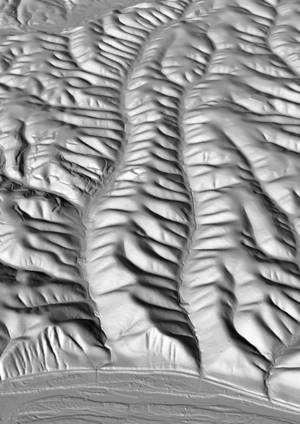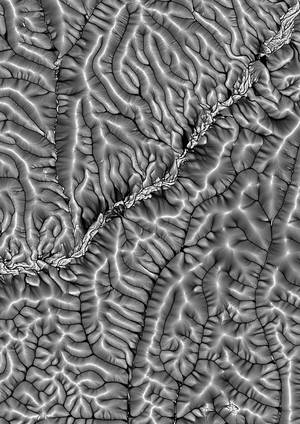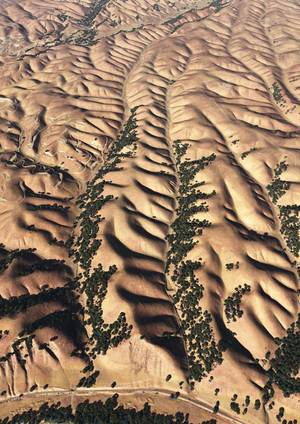Chris - Now if you glance out of the airplane window as you're surging, not across the ocean, but across land, how could you have missed those wonderful ridges and valleys you see and not fail to notice that they form very regular patterns? It's almost like the teeth of a comb. Why should that be? Is it just a freak of nature or is there actually a mechanistic reason why it's happening? Well Dr Taylor Perron, who's a researcher at MIT in America, has got a paper in the journal Nature this week, and he and his colleagues have cracked the reason it happens. Hello, Taylor.
 Taylor - Hi Chris.
Taylor - Hi Chris.
Chris - Welcome to the Naked Scientists. Tell us why do we see these amazing patterns in nature?
Taylor - Well, we started wondering about this pattern for the same reason that the people you just referred to looking at the airplane window did. Whenever you see a pattern that's this regular and widespread in nature, it's got to be telling you something about the physics that are generating it.
Chris - So we're talking here about the way you see a hillside, then a ridge or a river right between it then another hillside and so on. You get that beautiful repeating pattern.
Taylor - That's right. It's been recognised by geologists for more than a century that there is this very even spacing among rivers or, equivalently, between the ridges that separate them.
Chris - So how did you set about trying to solve this conundrum?
Taylor - We first put together a theoretical model that was based on some field observations we made. So we went to a bunch of sites around the United States where we saw this pattern very well-expressed and we looked on the ground to see what was happening there, shaping the landscape. And we ended up putting together a model that combines two basic processes that are competing against one another that creates this even spacing of ridges and valleys.
Chris - And what are they?
Taylor - And it's a basic balance between one set of processes and chief among them is river incision that de-soils a rock; that tends to cut into landscape and create valleys. That tends to make them spaced more closely together. But competing against river incision is soil creep which is the gradual down-slope movement of soil due mainly to stirring by organisms that are burrowing in the ground. And that tends to fill in the valleys, round-off the ridge lines and make them spaced more widely apart.
 Chris - But why should they be so regular though, Taylor? Why not just have a few here and there? Why this beautiful regular pattern we see?
Chris - But why should they be so regular though, Taylor? Why not just have a few here and there? Why this beautiful regular pattern we see?
Taylor - Well, there's an interesting story there too and it actually has a bit of a Darwinian flavour to it. This is one of the best parts of the study for us. This is a pattern that emerges over many thousands of years. By writing the equations to describe these erosion processes and solve them into a computer we could fast-forward the evolution of the landscape over those many thousands of years. And here's what we see happening:- when a landscape first starts to form, the initial valleys that develop are unevenly spaced. But some of them are a little bit larger than others and some of them are farther from their neighbours than others. The ones that start out bigger or spaced farther from their neighbours are able to capture more water and, therefore, erode more rapidly. And they grow faster and they pinch out their smaller neighbours. And so it's this competition for water that ultimately leads to an even spacing.
Chris - So presumably, you can tweak your formula to accommodate the fact that some areas of Earth are dryer, some are wetter, some have harder rocks, some have softer rocks, and all of those things will presumably affect this erosion competition that you've got going on.
Taylor - It's exactly this that we're ultimately trying to get at: how do major factors like the type of rock that the landscape is made of, like the intensity of biological activity and climatic effects like rainfall influence this wavelength? And by comparing these different sites and also using the theoretical model to explore this, we have found that there are some pretty significant effects there. For example, if you have a landscape that's eroded into harder rock the ridges and valleys will generally be spaced wider apart. We also have found that in places that are wetter where they'd get more mean annual rainfall you also have wider valley spacing. So there very definitely are some fundamental controls on this pattern.
Chris - So given that you've got this very old record of erosion and you can infer and you now know because of your formula, how they form and over what sorts of rates. Does this mean that written into the landscape is quite literally a record of past climate in the form of rainfall because of the erosion pattern?
Taylor - That's right. And that is one of the things that this pattern is recording. The challenge for us next is teasing out the relative importance of these different effects. So for example, we know that rainfall has this effect of making valleys spaced wider apart but we're not exactly sure of what the absolute magnitude of that effect is in a given place because it's kind of convolved with the bedrock strength and other factors. But ultimately, yes, there is a record here that we can start to interpret now.
 Chris - And just very briefly to finish, the last time I spoke with you, you were discovering why the coastline of an ancient ocean on Mars seemed to rise and fall by up to three kilometres in places. Does this work also inform those amazing rivers and valley type systems that we think we can see on Mars with Mars Express and the other things that are looking at the surface of Mars from space?
Chris - And just very briefly to finish, the last time I spoke with you, you were discovering why the coastline of an ancient ocean on Mars seemed to rise and fall by up to three kilometres in places. Does this work also inform those amazing rivers and valley type systems that we think we can see on Mars with Mars Express and the other things that are looking at the surface of Mars from space?
Taylor - I think it does. One of the things that first inspired us to look into this problem was not just observations of landscapes on Earth but also images that we saw of Mars where you do see mind-bendingly irregular patterns of erosional features on the sides of impact craters all over the planet. And although the same exact processes are not at work, clearly the soil creep on Mars is not driven by biological activity but more likely by, say, the activity of ice in the ground. We think it's the same basic competition between valley cutting and valley filling processes that does it there. So one of the - part of the appeal of this is that we can now go to landscapes either on earth or another planets where all we have is remote observations and start to learn something about how the landscape is developed over many years.
Chris - So it's not just aliens then. Thank you very much Taylor.
Taylor - That's right.
Chris - Dr. Taylor Perron. He is the researcher at MIT in America. He's got a paper in this week's Nature, explaining why we see those regular patterns of ridges and valleys forming across the landscape.










Comments
Add a comment